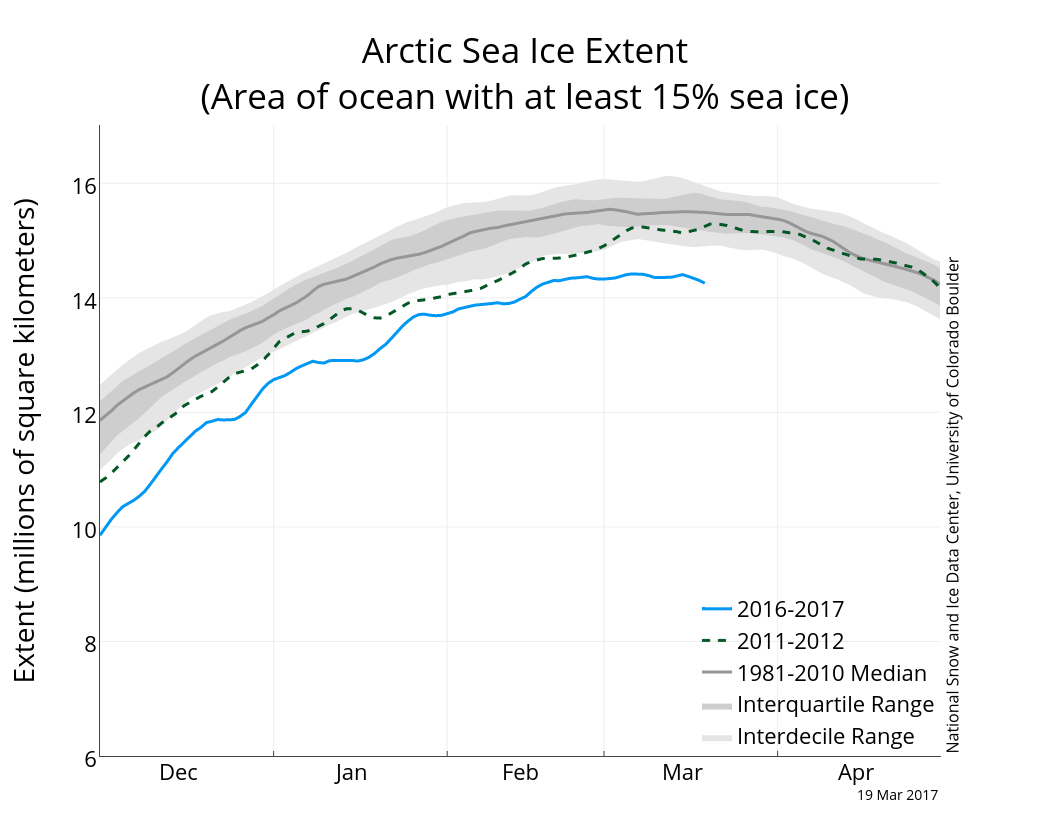Black carbon measurement methods and emission factors from ships
Blog
Quibbles over the perfect way to measure black carbon emissions from ships are keeping us from commonsense moves to control them
At a time when Arctic sea ice should be nearing its maximum extent, we’re seeing record-low ice cover for this time of year. It’s so hot at the pole that scientists are toying with ideas to re-freeze the Arctic ice cap — not kidding.
This melt is but one symptom of human-induced climate change in an area warming more than twice as fast as the rest of the planet. Avoiding the most catastrophic impacts of climate change requires immediate action to reduce climate pollution from all sources. While everyone agrees that the key part of the solution is to reduce and eventually eliminate carbon dioxide emissions, this is the long game. To make an immediate difference, cutting short-lived climate pollutants, or SLCPs, is what we have to do. And for the Arctic especially, that means black carbon—even more exactly, soot in ship-engine exhaust.

Source: National Snow and Ice Data Center, University of Colorado Boulder
Black carbon is 3,200 times more potent a climate warmer than carbon dioxide pound-for-pound over a 20-year timescale. As we noted here, black carbon from ships accelerates warming and melting in the Arctic by depositing dark particles on snow and ice. The need to reduce black carbon emissions from ships is clear and urgent. What’s being done?
Not enough. No country regulates black carbon emissions from ships, and international environmental policies, including the upcoming 0.5% fuel sulfur limit from 2020 and beyond, do nothing to reduce black carbon and may make things worse. We need to do better.
Discussions on how to define, measure, and control black carbon from marine engines have dragged on for years at the International Maritime Organization’s Pollution Prevention and Response (PPR) Sub-Committee. It took four years for PPR just to finally agree on a definition of black carbon in 2015. Since then, researchers from the U.S., Canada, Japan, Germany, Finland, and engine manufacturers have been testing various ways to measure and control marine black carbon emissions. The results of their studies were submitted to the 4th session of PPR, which met in London 16–20 January 2017. But the pace of progress at PPR on controlling black carbon from ships remains painfully slow.
At issue now is whether or not we know enough about black carbon and how to measure it to start talking about mitigation measures (read: international policies that reduce black carbon from ships in the Arctic and maybe globally). It seems that some IMO countries prefer to delay by debating the fine details of how to measure black carbon instead of discussing what steps might be taken to control it.
In fact, considerable progress has been made over the past two years in determining best method(s) of measuring black carbon from ship engines; see the presentations and summaries from the series of technical workshops sponsored by the ICCT here, here, and here. And more similar work is in the offing: we will be convening experts ahead of PPR 5 (2018) that will build on recent research from scientists in the US, Canada, Japan, Germany, Finland, the Netherlands, as well as from engine manufacturers.
One example of new research that will feed into that upcoming workshop is a study conducted by a University of California—Riverside (UCR) research consortium, commissioned by the ICCT, with funding from the U.S. Maritime Administration (MARAD), the Climate and Clean Air Coalition (CCAC), and in-kind support from Environment and Climate Change Canada (ECCC) and National Research Council Canada (NRC). This study found that distillate fuels emitted the least black carbon compared to other fuels, including heavy fuel oil (HFO) and a desulfurized residual fuel. In fact, the desulfurized residual fuel (0.0013% sulfur content) had the lowest sulfur content of the fuels tested but the highest black carbon emissions. Similarly, researchers from Finland found that a 0.5% sulfur marine fuel had the same or higher black carbon emissions as conventional marine fuels. These are important findings because some IMO delegations are hoping that when the 0.5% global fuel sulfur standard goes into effect in 2020 black carbon emissions from ships will automatically fall. These studies indicate that new fuels formulated to meet the 0.5% fuel sulfur standard may be just as bad as conventional marine fuels, or even worse.
So what are we to do? Without regulation it’s unlikely that the international maritime shipping sector will voluntarily find ways to cut black carbon emissions, despite the climate benefit. Thus, we must make progress at the IMO, the body that regulates international shipping. We need to move on from quibbling about the “perfect” measurement method and start debating the opportunities to cut black carbon emissions. But we must move quickly. Because the Arctic we’re aiming to protect can’t keep its cool much longer.
